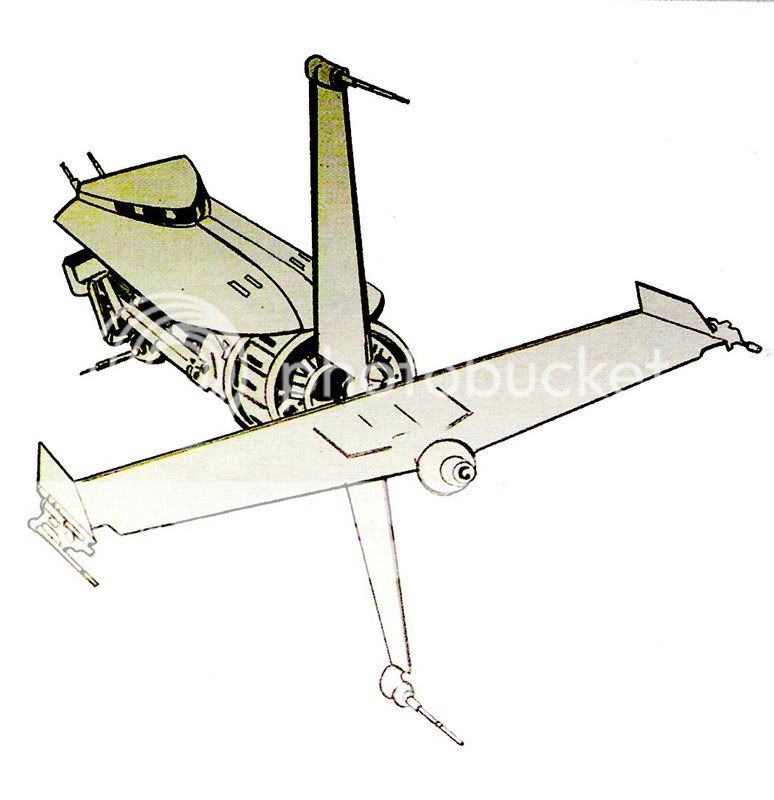|
|
|
|
|
|
|
|
|
 Posted: Wed Oct 04, 2006 8:05 am Posted: Wed Oct 04, 2006 8:05 am
 |
 |
 |
 |
Entry: 155000
Subject: Shield Systems
Status: Canon
Capsule:
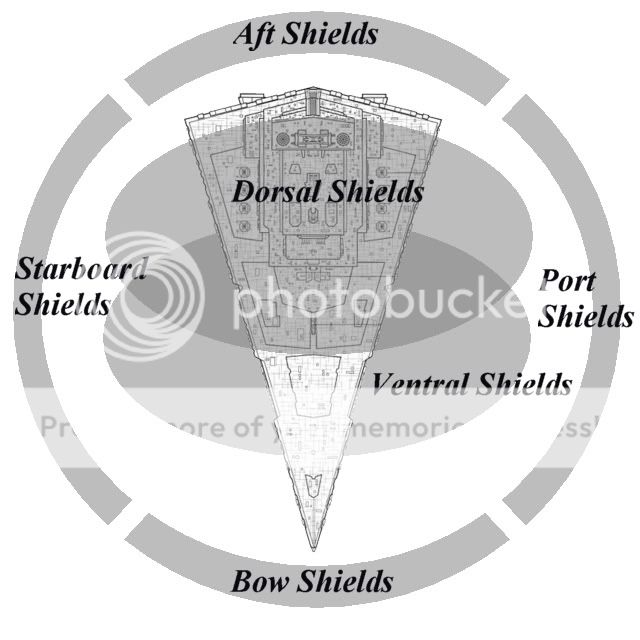
Shields… never leave home without em. Seriously. If you don’t want to get vaped by an upty pirate, blasted by an ISD, or irradiated by a particularly vicious star you’ll want these babies. There are many kinds of shields and on most ships they are divided into six shield vectors: bow, stern, port, starboard, dorsal, and ventral. Each shield is powered by a separate set of shield generators in normal operations though most combat ships can realign the shield power from one vector to another… though this often greatly reduces the power of the shields from which the generator is being realigned.
Most of the time the shield generators are buried deep within the ship and are therefore protected from direct attack, luckily impacts on the shield stress the generator and therefore can cause generators to overload or short out resulting in shield collapse. While generators may not be vulnerable to direct attack their emitters are, many an imperial warship has lost its dorsal shields with the destruction of the sensor globes because of the placement of the emitter vanes on those globes.
There are many unique and lesser known forms of shielding, some much more useful then other.
Multi-vectoral Shielding:
This form of shield is really uncommon and most ships equipped with it are of the sorts that almost never use shields anyway. A Multi-vectoral shield system is designed so that all the generators feed into all the vectors of the ship thus making it so that the ship is under one whole shield, an impact in one vector will affect shield strength in all vectors. The only reason to use such a system is for vessels that lack the speed and maneuverability to keep strong shields to bear on an enemy vessel.
Primary and Secondary Shielding:
A simple and common enhancement for military vessels is the use of Primary and Secondary Shielding. This enables the ship to take a much greater beating because it wraps in the vessel in two layers of shields. If the primary shield collapses in a vector the secondary shield stops what passes through the collapsed area.
Regenerative Shielding:
A hallmark of Mon Calamari ship design is the use of banks of regenerative shield systems. How this works is that every Mon Calamari ship has a bank of shield generators for an assigned vector, but only a few of them are active at any one time. When a shield collapses the additional shield generators kick in while the primary generators are repaired thus enabling the shield to suddenly reappear over the area that was once vulnerable.
Ray Shielding:
Almost every starship will come with some form of ray shielding, ray shields protect against energy including harmful radiation and part of the weapons fire. Some ships that operate around particularly nasty solar and astronomical conditions will have significantly greater shield systems. A good example would be the Shield Ships that Lando Calrissian had at Nkllon.
Magnetic Shielding:
This shielding is a specialized form of ray shielding designed to stop harmful radiation, its usually only mounted on large space stations and unprotected planets. Flying through the shield is possible but uncomfortable much like flying through the magnetic field of a planet. The first Death Star was protected from radiation by this type of shield.
Particle Shielding:
Ray shields might stop radiation and screw around with laser fire but they aren’t any good against a rock. That’s where particle shielding comes in, it’s almost unheard of for a ship to have exclusively particle shielding… Most ships have both particle and ray shielding. Particle shielding helps stop laser fire because it stops the superheated plasma that composes the bolt which is a particle.
Deflector Shielding:
Don’t rely on deflectors for anything! EVER! Deflectors are a common part of any ray shield system, they emit a small magnetic field that is designed to spread out incoming charged particles so that they can be more easily be absorbed by the ray and particle shields. This effect is known as bolt splitting in that it creates a series of “daughter bolts” which are spread across a larger area of the shields or hull. If the deflector fails it may impair your ability to absorb additional damage but it isn’t necessarily a death sentence.
|
 |
 |
 |
 |
|
 |
 |
|
|
|
|
|
|
|
|
|
|
|
|
|
 Posted: Mon Oct 09, 2006 7:46 pm Posted: Mon Oct 09, 2006 7:46 pm
 |
 |
 |
 |
Entry: 17000
Subject: Canderous-class Frigate
Status: Fanon
Capsule:
Developed by MandalMotors after the second Mandalorian Civil War, the Canderous-class reflects the dramatic changes that came along with the ascension of the Mandalorian Deathwatch as the occupiers and owners of Mandalore. The vessel was meant initially as a replacement for the aging Kedalbe-class, but problems with development costs and delays led to the ship first entering service as an adjunct to the older ship.
With the stunning performance of the new Imperial Missile Destroyers that had begun appearing during the Sith-Imperial war, the designers at MandalMotors shifted the focuses of the Canderous-class away from Turbolaser cannons. Despite this the ship was centered on a single central energy weapon. The Plasma Particle Beam Cannon, or PP-BC, formed the central spar of the vessel and was developed to be a weapon capable of destroying ships of far greater size and strength then itself. Unfortunately the cannon would prove to be as much a handicap as an offensive tool.
Firing the PP-BC resulted in the complete draining of the Tibanna gas reserves onboard the vessel. This meant that once fired the ship would be unable to use any of its energy weapons until the gas reserves were replenished at a star-dock. Additionally the power required to fire the weapon would completely drain the power core, rendering the vessel incapacitated until the generators could recover, a period of about thirty seconds of complete lack of shields, sensors, and engines. Finally the weapon’s effective range was extremely limited due to the plasma beam’s tendency to be disturbed by the ionic effects of other energy weapons and the solar wind, the weapon could only be certain of causing damage at point blank ranges.
Partly to counter the shortcoming of the PP-BC, and taking the lessons dealt by the Stalwarth-class during the Sith-Imperial War the MandalMotors design team installed twenty clusters of missiles, each cluster held five Class-9 Heavy Torpedo Tubes. In addition to the missiles the designers placed three Class-3 Ion Cannons, eight Class-7 Ion Cannons, twelve Class-7 Laser Cannons, two Class-12 Turbolasers, eighty Class-7 Turbolasers and two Class-20 Turbolaser Pulsers. The Turbolasers Pulsers fired directly forward, much like the main gun, thus limiting their utility.
Because of the focus on forward firing weapons the ship was incredibly maneuverable, capable of making a 180 degree turn in less than ten seconds. Despite that the ship’s primary engine systems were incapable of propelling the vessel faster then 35 MGLTs.
The ship reflected a number of older mandalorian traditions when it came to crew capacity and survivability. The ship had a crew complement of just below two hundred; this was made possible through the extensive use of slave circuitry and automation.
For armor the ship used a unique mandalorian alloy that was very similar to that utilized in Mandalorian body armor, this gave the ship immense structural strength. You were more likely to eliminate the vessel as a threat by incurring crew losses in your attack then you were to cause its destruction. Additionally the missile tubes were designed so that they could be ejected from the ship in the case of fire or critical failure. Finally the ship featured a classic double hull and the placement of the Tibanna gas reserves immediately around the primary cannon’s xciter.
This was done for two reasons, firstly the Tibanna gas had to be close to the main cannon’s xciter in order for enough gas to be on hand to fire the weapon. Secondly the designers hoped that placing the gas there would keep it clear of hostile weapons fire. They didn’t anticipate the use of ion cannons against the ship. An ionic charge could easily cause the PP-BC to destabilize during power-up and charging. Such a hit would result in the detonation of the tibanna gas within the vessel certainly destroying the vessel in the process.
Like most mandalorian vessels, shields were of secondary importance, in combat only a single belt of shields are deployed unlike with most other combat vessels. Fortunately for its users the hull is strong enough that the second set of shields is not required.
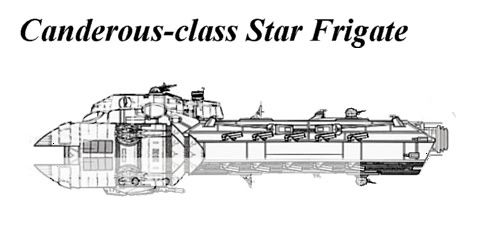
|
 |
 |
 |
 |
|
 |
 |
|
|
|
|
|
|
|
|
|
|
|
|
|
|
|
 Posted: Tue Oct 10, 2006 7:36 am Posted: Tue Oct 10, 2006 7:36 am
 |
 |
 |
 |
Entry: 18000
Subject: Nemesis-class Star Destroyer
Status: Fanon
Capsule:
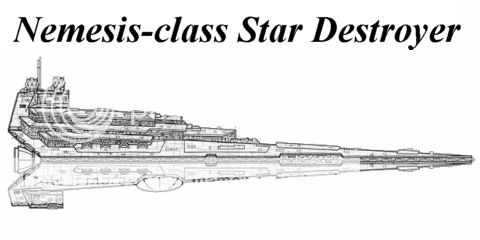
While the Imperial Starfleet expanded after the vong invasion the Imperial-III Star Destroyer was its primary weapon, now generations later a new Star Destroyer from the Kuat Drive Yards is making its presence felt as the replacement to venerable old Imperial Line, the Nemesis-class.
Unlike the Stalwarth-class or the Revenge-class the Nemisis-class is designed exclusively as a mobile turbolaser platform. With the basic arrowhead shape of the old Imperial Star Destroyer as a starting point the Nemesis-class became a monster of a combat destroyer, heavier then its predecessor and much more powerful, the ship had a range of drawbacks including slow speed, light starfighter compliment, and a lack of troop deployment capability. In the new imperial fleet the specialization of vessels made the old multi-role capability of the ISD a drawback rather then an advantage.
The Nemesis is armed with 128 Class-12 Turbolasers mounted in sixteen octagonal mounts, 240 Class-8 Turbolasers, 120 Class-7 Ion Cannons, 12 Class-9 Laser Cannons, and 12 Class-12 Proton Torpedo Launchers. This gives the ship enough offensive firepower to be a threat even to the Revenge II-class Star Cruiser. The ship’s small hanger bay is only large enough to carry a maximum of four fighter squadrons or 48 starfighters, and its engines only deliver sufficient thrust for the vessel to make a top speed of 11 MGLTs extremely slow for a modern Destroyer. It also uses a relatively slow class 1 hyperdrive. Still its double shielding and double hull design enable it to take a pounding that would destroy almost any other destroyer.
The ship is a mobile fortress, and its utility in line engagements has made it feared among tactical officers in the terrifying position of having to face it in battle.
|
 |
 |
 |
 |
|
 |
 |
|
|
|
|
|
|
|
|
|
|
|
|
|
 Posted: Thu Oct 12, 2006 5:59 pm Posted: Thu Oct 12, 2006 5:59 pm
 |
 |
 |
 |
Entry: 18025
Subject: LT Transverter
Status: Fanon/Canon (Depends on how you look at it)
Capsule:
You've surrounded the planet. You have hundreds of ships on yourside, and the Rebel scum is mere moments away from being vaporized into dust.
But BLAM!, and next thing you know, everything goes dark, and the entire ship tilts dangerously to the side. What the hell just happened?
You've been hit by the LT Transverter.
Folks, this is the best EMP tech has. So far there's only one, but the sole device itself is worth as much as a Pellaeon, considering what it can do.
Like normal EMPs, it disables just about all electronics in the area. This would be a good thing if EMPs hadn't been obsolete for the past several centuries, thanks to EMP shielding.
However, this goes a step beyond. Basically, it's a self-shielding ion bomb.
~CRASH COURSE ON EMP~
Basically, EMP: Hardware as Viruses: Your Precious Hardrive
However, there is a defense. Using special EMP shielding, you set your hardware to a certain frequency. Once set to that frequency, the shield cancels the effects of all EMP working at that set frequency.
For the longest time, all EMPs worked on a few, limited frequencies, and no one could figure out how to work around them. Thus, the EMP essentially became extinct.
However, the LT is better. Once plugged into your own power, it can figure out which settings your enemies tech is defended against, and then set itself on a different frequency. Now, this would normally wipe out everything, but here's the best part. The device comes with a protoype shield that automattcially protects it and anything networked to it against the EMP.
In a nutshell: you can fry your enemie's entire fleet, and then run off laughing your head off.
There are some limitations though. While it does knock out weapons, shielding, power, and just about everything, it doesn't seem to effect life support systems. Also, there's an extremely low chance at permanent damage. Range is good at up to eight miles.
With it, you can pretty much kill the enemy fleet, and run. They'll have about five minutes to figure out what happened and how to start fixing it, and at least half an hour to get minimal settings up. In any case, their ships won't be ready to fight just about anything for several hours, and you can keep on at it.
*Note- Works on any hardware and vessels, including tanks, command speeders, guns, personel shields, comlinks, lightsabers, starfighters, ships, planetary shields, and just about anything else except for life support systems (disabling that would count as god-modding).
WARNING- Protect any datapads and microchips that may be vulnerable. Anything lacking proper shielding or plating, even on a minimal level, will likely be fried.
|
 |
 |
 |
 |
|
 |
 |
|
|
|
|
|
|
|
|
|
|
|
|
|
|
|
 Posted: Thu Oct 12, 2006 6:00 pm Posted: Thu Oct 12, 2006 6:00 pm
 |
 |
 |
 |
Entry: 18030
Subject: Jorus and Joruus C'baoth
Status: Canon
Capsule:

Jorus C'baoth was one of those crazy Jedi. You know, the ones with deranged ideas of grandeur and infallible power? He started off young and all, but he got ranked pretty high, pretty early. By the time he was thirty, he was calling himself Jedi Master.
He was also know to use this thing called Force Meld, which basically linked Jedi together into one strong bond of Force power. Basically, really good Battle Meditation.
Jorus was to head the Outbound Flight project, but along the way, he ran into Impirial Forces commanded by Palps, and some chiss blokes led by none other than Thrawn himself. In the ensuing battle between the Outbound Flight, Chiss, Vaagari invaders, and Impirials, C'baoth died.
But not before Palps got a blood sample from him. No sooner was Jorus dead than the Emperor had a clone of him grown at his own summer home on Wayland.
As fate would have it, Thrawn turns up later as a Grand Admiral, and when he gets to Wayland to seize the cloning tech there, he finds the crazy old Jedi he already killed. (According to Vader, this is pretty irritating)
Thus we have Joruus C'baoth. If his predecesor was crazy, then this guy was plum loco. Grown in under twenty days, he was prone to what we call Clone Madness, which brought about Force-powered tantrums and the like. He was obsessed with becoming his own Emperor, and constantly argued with Thrawn over those same reasons.
Like all Dark Jedi Masters of the area, he was obsessed with converting Luke and Leia, as well as Mara Jade to his side. He even went as far as cloning Luke using the hand he lost on Bespin. They eventually beat him, bringing the whole mountain down on top of him with the help of the Noghri.
The only real notable thing this guy did in regards of the Jedi (or rather the Sith) was Mind Domination. You'll find out about that later, but let's just say it completely screwed up this guy called General Covell...
|
 |
 |
 |
 |
|
 |
 |
|
|
|
|
|
|
|
|
|
|
|
|
|
 Posted: Thu Oct 12, 2006 6:01 pm Posted: Thu Oct 12, 2006 6:01 pm
 |
 |
 |
 |
Entry: 18045
Subject: Force-ability Dominate Mind
Status: Canon
Capsule:
Once upon a time, there was a guy called General Covell. He became friends with an insane Dark jedi called C'baoth, and next thing you know, his mind got replaced and he died. The End
This is something you never want to experience. EVER. Basically, this makes that trick convincing Stormtroopers that these aren't the droids they're looking for look like some kind of crappy joke. This doesn't convince people to do something; it doesn't even order the person to do anything.
It replaces their mind.
Only one guy, C'baoth, ever managed to do it, but all he did was use his extensive knowledge of the Force to remove parts of General Covell's mind, and placing parts of his own in it. He was trying to create his own mental clone; giving him a second shot at life.
All in all, this isn't pretty. Anyone does it to you, you can kiss your beloved illegal freighter goodbye. The only thing that'll matter any more is whoever's sliced apart your cerebrum and whatever he or she wants. Best you could hope for is either someone kills him, or uses ysalamiri to cut the Force off between you; that way, you at least die without the tortures in your bleek future.

|
 |
 |
 |
 |
|
 |
 |
|
|
|
|
|
|
|
|
|
|
|
|
|
|
|
 Posted: Sat Oct 14, 2006 11:02 am Posted: Sat Oct 14, 2006 11:02 am
 |
 |
 |
 |
Entry: 18050
Subject: Imperator Series of Star Destroyers
Status: Canon
Capsule:

They have been the symbols of imperial might and authority for over fifty years, and have fought in three galaxy wide conflicts. These vessels are the heart and soul of the Imperial Navy dating from the Clone Wars to the Vong Invasion and beyond. Called a number of different names, the Imperator Series, the Imperial Line, or the Tector Line these vessels form the backbone of the Imperial Fleet.
Know them, love them, or hate them. Just be sure you’ll have to face them at some point.
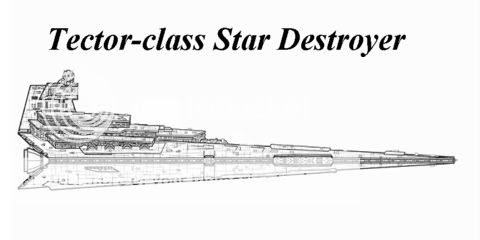
The venerable line of the Imperial/Imperator series doesn’t begin with the Imperator-class, but a lesser known warship that fought alongside the Acclamators and Venators of the Clone Wars, the Tector-class. The ship would see service until at least the Battle of Endor where several of these vessels assisted in the engagement.
The Tector-class is the only member of the Imperator Line to lack a hanger or reactor bulb, this reflects its design and the doctrine of the Republic navy at the time. The Tector was meant as a direct combat starship that would be supported in combat by starfighters from other ships such as the Venator. Few of the ships saw active service due to a number of limitations including slow speed, support requirements, and crew requirements. Its armament is roughly about equal to the armament later given to the Imperial I.
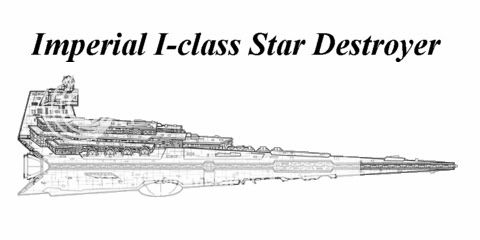
Launched just after the end of the clone wars the Star Destroyer Imperator was meant as the launching point of a new class of combat ships, the Imperator-class. Soon after its launch the ship and its class were renamed Imperial-class starships by the personal decree of the Emperor. This ship is not one you want to face… period. She’s fast for a Star Destroyer and is capable of running down a CR90 Corvette with a gravitational assist. Not only that, she’s armed to the teeth.
Most people only read the official public statistics for this vessel provided by the Imperial navy, and immediately are given the wrong impression of just how well armed she is. The often vastly underestimate the assembled firepower of the ship because of the use of the Imperial misnomer of Turbolaser Batteries. This can be quite a poor way to categorize the ship’s weapons array, after all a battery can mean between one to eight guns. A much more accurate way to tell the ships firepower is to list it by individual guns.
The Imperial I carries a grand total of: 12 class-10 Turbolasers, 4 Class-5 Ion Cannons, 240 Class-5 Turbolasers, 120 Class-3 Ion Cannons, 8 Class-2 Laser Cannons, 2 Minelayers, and 6 Class-6 Heavy Torpedo Tubes. Additionally the ship houses a total of 72 Tie Starfighters and a plethora of supporting craft in its cavernous hanger bay. Her Hyperdrive is a Class-2 making it adequate for rapid response to incidents within her patrol area.
You don’t want to find yourself facing down all those turbolasers, and if that armament was scary just hold on for the next class.
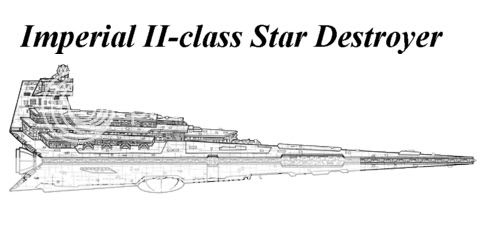
Apparently in development before Yavin, the Imperial II would become the cornerstone of the Imperial Starfleet for the next thirty years even seeing service in the Vong Invasion. She’s got all the basic abilities as her older cousin but a heavier hull and much heavier armament.
The ship has a dramatic increase in offensive turbolaser armament, now she’s equipped with: 64 Class-10 Turbolasers, 200 Class-7 Turbolasers, 100 Class-4 Ion Cannons, and 8 Class-2 Laser Cannons.
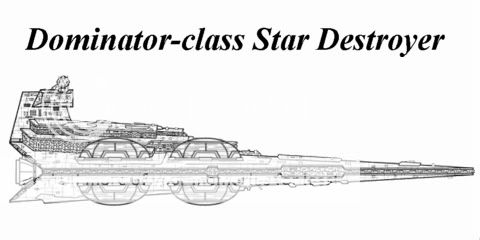
After Endor and after loosing a number of the venerable Im-418 Interdictor Cruisers in combat the Empire began commissioning a new type of Interdictor ship based of the Imperial-II Star Destroyer’s hull. The ship sacrificed offensive firepower by doing away with the Class-10 Turbolaser batteries to make room for four Gravity Well Projectors. This makes her a large and well protected Interdictor ship, in combat operations this ship is usually paired with another combat centered Star Destroyer like an Imperial II.

Shortly before the Imperial Remnant’s surrender and peace treaty with the New Republic the Empire commissioned its latest incarnation of the Imperator Series, the Imperial-III. Additionally a number of Imperial-IIs were upgraded to Imperial-IIIs among them was the Chimaera.
The upgrades that came along with the Imperial-IIIs didn’t affect offensive firepower as much as it did survivability. The armor plate was given appliqué armor as well as the addition of a cloaking device standard. The ship was still quite well armed with: 64 Class-10 Turbolasers, 200 Class-7 Turbolasers, 80 Class-5 Ion Cannons, 6 Class-6 Heavy Torpedo Tubes, and 10 Class-2 Laser Cannons.
This class was never put in full scale production due to the expense of installing a Cloaking Device and would serve primarily as an adjunct to the older and venerable Imperial-II.
|
 |
 |
 |
 |
|
 |
 |
|
|
|
|
|
|
|
|
|
|
|
|
|
 Posted: Sat Oct 21, 2006 12:46 pm Posted: Sat Oct 21, 2006 12:46 pm
 |
 |
 |
 |
Entry: 92562
Subject: Golan Arms G-3HJ
Status: Fanon
Capsule:

The G-3HJ is a next-generation blaster rifle developed by Golan Arms to give the company a competative edge in the burgeoning military market during the Legacy era. The weapon is incredibly powerful due to the improvement of plasma technology, and to make up for the increased heat given off, it is equipped with a liquid cooling system which includes a tank and pump. It is attached over the forward body of the rifle, and feeds into a capillary system that cools the blaster module. The barrel is cooled using traditional air vents.
The G-3HJ comes with a powerful HS scope which can be linked wirelessly to project into a helmet's HUD. It has enough power for 150 shots per blaster pack, loaded into the bottom of the stock. It can accomodate other blaster pack designs, but the erganomics normally suffer from such a practice. The G-3HJ carries enough gas for 5,000 shots, which can be refilled into a tank in the stock that connects to the blaster module.
The weapon is formidable in a firefight, capable for several seconds of fully automatic fire without serious risk of overheating. However, it is heavy, and the cycling motion of the liquid coolant can throw off aim or balance, although the scope compensates for this with finesse. It's accurate enough that the G-3HJ is competent as a marksman's rifle, although it is best suited for close combat and medium-distance engagements.
|
 |
 |
 |
 |
|
 |
 |
|
|
|
|
|
|
|
|
|
|
|
|
|
|
|
 Posted: Sat Oct 21, 2006 12:47 pm Posted: Sat Oct 21, 2006 12:47 pm
 |
 |
 |
 |
Entry: 945726
Subject: Blas-tech E-54
Status: Fanon
Capsule:

Blas-Tech's E-54 is heralded as a 'real' replacement for the iconic E-11 blaster rifle, used during the Galactic Cival War and well into the Yhuzaan Vong invasion. Keeping the previous requirements of compact size, good range, redundant cooling, and high energy output and building upon them for a new era of warfare, Blas-Tech created the E-54. Even more compact than the aged E-11, it still retains the capability of becoming a firearm with longer range via a collapsable stock that slides over the body of the weapon and helps it maintain a compact size.
As with the E-11, air vents and coolant capillaries are used across the body of the weapon, but a seperate chamber has been added over the body of the weapon devoted to cooling. Because the chamber itself hugs the length of the weapon, it does little to sway the balance while functioning.
And boy, does the E-54 need the cooling, because it packs a real punch. On full automatic, it can let loose 500 blaster bolts per minute, after which it's barely warm to the touch. On semi automatic (or "one shot at a time"), it is accurate to a tee, much improved over its predecessor, and the standard scope, although lacking in range, still functions effortlessly and integrates easily with most HUDs and holographic displays.
However, the clip is limited to 200 shots, and the clip requires cooling vents. The blaster module has been expanded slightly, providing the punch of current (Legacy-era) blaster (or "plasma" if you prefer) rifles in what is still a relatively small package. To access the module and remove it for maintainance, one needs only to extend the stock, and the module can be extracted out of the back of the weapon, much like that of the E-11.
Blas-Tech kept non glove-wearing shooters in mind and developed well insulated materials to protect the hands of the firer. The foregrip, though jutting cooling capillaries and vents, fits comfortably into a roughly human-sized hand, and is easily gripped by even smaller species. The gun's grip is comfortable and made of a soft material shaped erganomically to fit a hand with five fingers or less.
|
 |
 |
 |
 |
|
 |
 |
|
|
|
|
|
|
|
|
|
|
|
|
|
 Posted: Thu Oct 26, 2006 12:18 pm Posted: Thu Oct 26, 2006 12:18 pm
 |
 |
 |
 |
Entry: 945098
Subject: Scythe-class main Battle Cruiser
Status: Canon/guestimation
Capsule:

The Galactic Alliance's answer to the Pellaeon Star Destroyer, the Scythe-class is a tough, hard hiting ship that makes up the spine of the G.A.'s Core Forces.
Only a Third the size of a Pellaeon and far more maneuverable, the Sythe-class can fight a Pellaeon and anything smaller to a draw.
Built from a Mon Cal design, the Scythe was armed with not only a standard compliment of cannon, but her Blade shaped Wing also held fighter launchbays and a collection of Capital grade Proton Torpedo launchers, allowing this vessel to serve multiple ruoles, from Command Ship, to Carrier, to Missle Cruiser, all without a change in the ship's configuration.
A dangerous combatant in its own right, the Scythe is even more dangerous given the fact that at one time the G.A. were cranking out huge numbers of these. Despite losses during the Sith-Imperial war, the Galactic Alliance's Core Forces still posseses enough of these ships to make the Sith Empire wary about engaging them again.
|
 |
 |
 |
 |
|
 |
 |
|
|
|
|
|
|
|
|
|
|
|
|
|
|
|
|
|
|
|
|
|
|
|
|
 Posted: Wed Nov 01, 2006 2:29 pm Posted: Wed Nov 01, 2006 2:29 pm
 |
 |
 |
 |
Entry: 451000
Subject: Ship Classification – Star Corvettes and above
Status: Interpretation
Capsule:
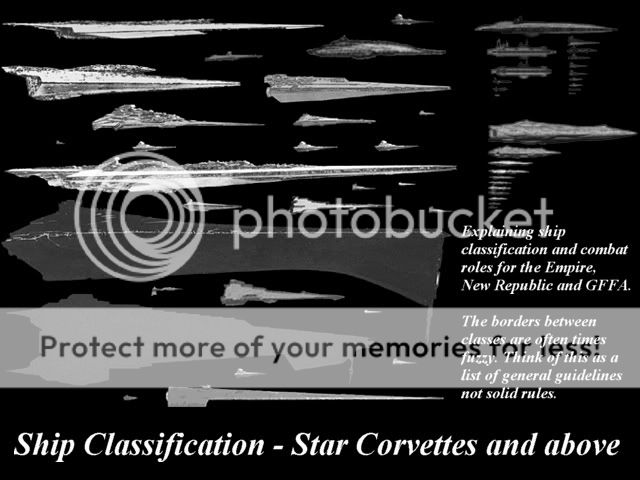
When someone says a starship is a Star Destroyer, Star Cruiser, or Star Defender don’t you want to know what they’re talking about? You should, because there is a world of difference from a Battlecruiser and a Star Destroyer, and the use of so many terms around the galaxy leads to a wide array of confusion as to what is what.
Firstly, we’re going to be using a classification system pioneered by the Imperial Navy. Only when naming conventions for the New Republic and GFFA deviate from the Imperial model will they be explained.
The length figures used are just general guidelines, most ships are placed in classifications based on their displacement, armor, armament, and speed, however since these differences tend to have a direct bearing on the ship’s size the designations given are fairly accurate.
It is important to note that many worlds have a separate naming convention from the Imperial system, and therefore the vessels produced from those worlds will have names which are not proportional to their Imperial Designation. Good examples of this are the Carrack Cruiser and Rendili Dreadnaught.
So… starting from the smallest vessels, besides starfighters we have…
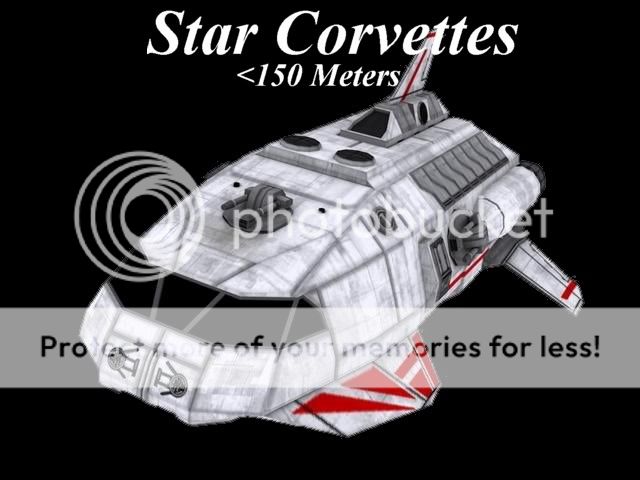
Star Corvettes, are the smallest combatant type of warship, they very in size and scale from the Skipray Blastboat to the KBD-1 Broadside-class and PB-950. Most all combat shuttles fit into this category and often times these ships serve only in secondary roles in any fleet engagement, primarily in the realms of reconnaissance, recovery, and close vehicle support. Some types of Star Corvettes are designed to serve as ultra heavy bombers in fleet operations, while others serve as convoy escort, system patrol, and general police operatives.
Star Corvettes are vulnerable to most forms of starfighters as well as and anti-starfighter capital ships. A Lancer Frigate can easily chew threw a couple flights of these craft, and capital ships do have a higher probability of success against these craft then normal starfighters with their turbolasers.
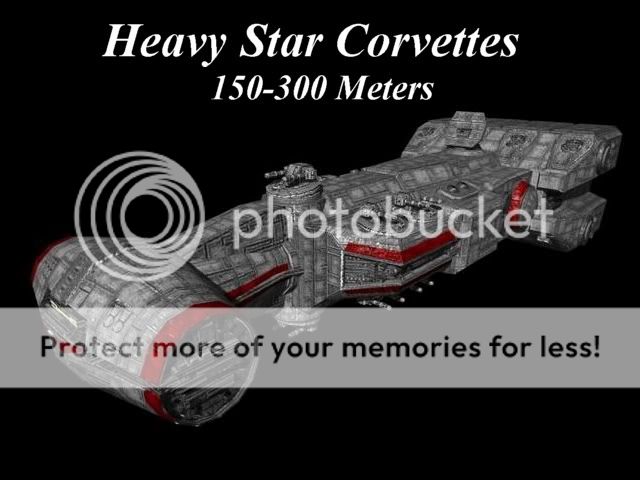
When a starfighter squadron isn’t enough, and you don’t have any heavy hitters available, bring in the Heavy Star Corvettes. While technically most of these vessels are larger then 150 meters, some forms of Corellian Gunship like the DP25 are classified as Heavy Star Corvettes because of their high firepower. These ships are used for a wide variety of tasks, ranging from system patrol to blockade running and convoy escort. In some fleets they’ve been pushed into front line combat duty… this has been especially true during the galactic civil war and the Rebel Alliance’s use of Corellian Corvettes and Gunships during fleet operations.
These Heavy Corvettes are often used to take on light frigates and sometimes even heavy frigates in small groups. They can not stand up against the might of a Star Destroyer, which usually is the most effective weapon against such a threat.
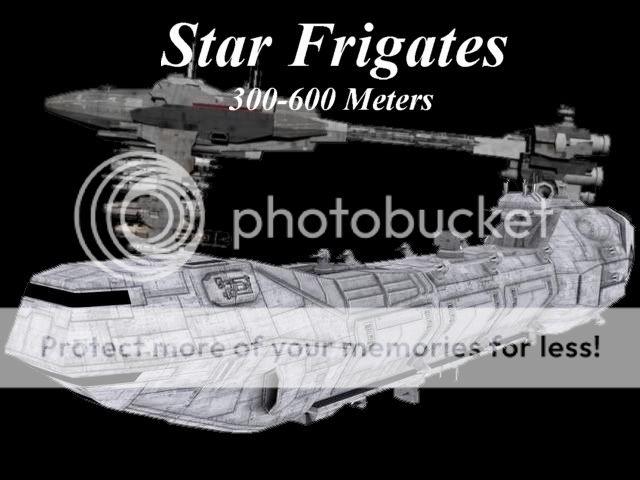
Star Frigates have an overwhelming tendency to be specialized and special purpose ships. Many of these ships are dedicated to the convoy escort and fighter suppression role, while others are dedicated to direct combat operations. Good examples of Star Frigates include the Nebulon B, Lancer Frigate, and Carrack Cruiser.
Ships of this class are most effective against smaller vessels like corvettes, though a small squadron may take on a heavy frigate if properly deployed and led.
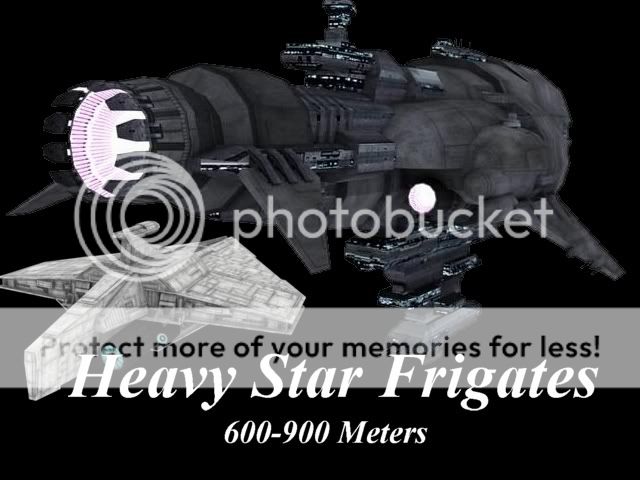
These ships form the backbone of most planetary defense fleets and independent systems as their largest capital ships. Despite that, on the galactic scale these behemoths are far smaller then most Star Destroyers in the Imperial inventory. Ranging from 600-900 meters means this ship is two big to be build in most factory style shipyards, and thus many of them have a production time of several weeks between units.
As a general rule of thumb, six heavy frigates can take on a Star Destroyer, but any smaller group will have immense problems with larger adversaries. In most fleet engagements heavy frigates serve to increase the anti-capital ship capability of the fleet and will operate closely to larger vessels to provide mutual support.
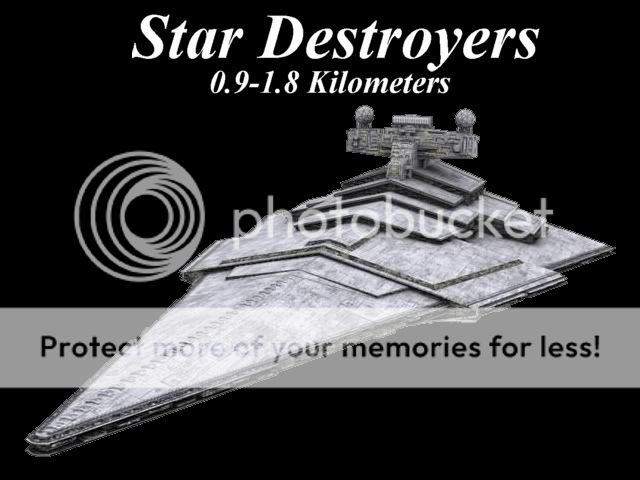
The backbone of the Imperial and New Republic fleets; Star Destroyers are designed to be highly versatile and capable of independent operations. They can be reconfigured quickly or immediately used to fulfill a wide variety of mission profiles ranging from sector patrol, anti-piracy, and espionage, to direct combat fire-support, planetary invasions and convoy escort. Examples include the Imperial class, Victory class, Harrow class, and Republic class. The MC series of Calamari Cruisers usually either fall in this category or heavy destroyer category.
While most people in the galaxy view star destroyers as the supreme overlords of space they are far from it, any true star cruiser, star battlecruiser, or star dreadnaught can easily overwhelm a destroyer.
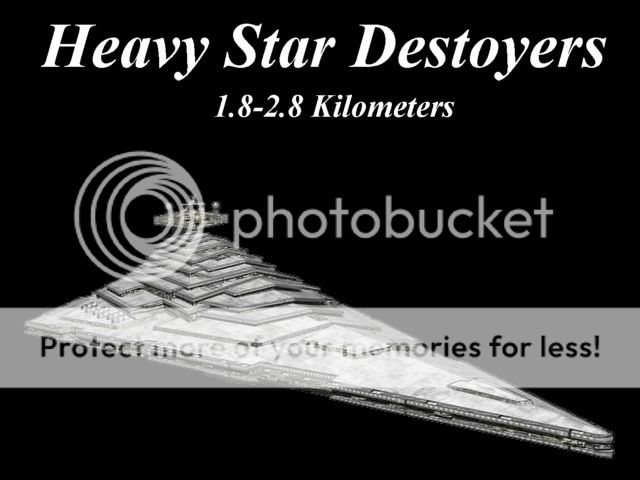
Unlike normal star destroyers, the heavy star destroyers are meant almost exclusively for use in fleet combat operations. They’re the smallest classification of vessels in the imperial inventory dedicated exclusively to fleet combat. These ships are often times only slightly slower and are much more heavily armed. Good examples include the Allegiance class, MC 90 series, and MC80B series.
Though well armed, these vessels are not as heavily armored as a cruiser, much less a dreadnaught, so it is quite possible to use two or more normal star destroyers to engage and eliminate such a vessel with proper planning and coordination.
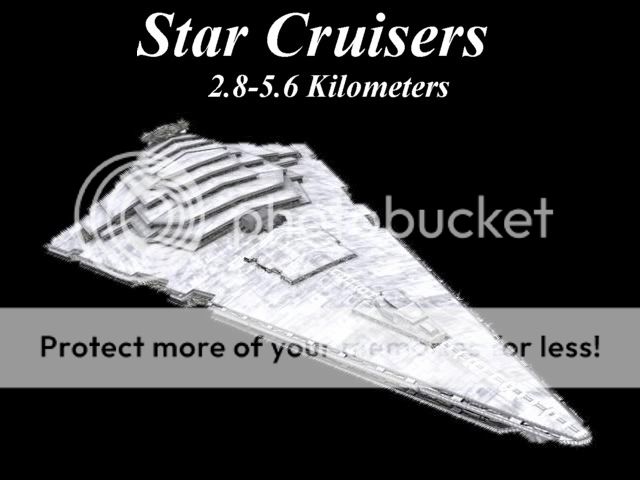
Most members of this class of ship are little known, and many of them have been labeled with the misnomer of being Super Star Destroyers, but these ships represent only the second tier of ships of the line for the Imperial navy. They’re slow, heavily armed, and more then capable of taking a beating. Classic examples of this classification include the Titan-class, the Tyrant-class, and Independence-class.
These ships are actually quite easy to defeat if they are left unsupported, they’re vulnerable to being outmaneuvered by smaller and faster destroyers. However with proper destroyer support they’re quite capable of making a name for themselves by racking up the losses on the smaller ships.

Star Battlecruisers or Star Defenders as they’re called in the New Republic are fast and heavily armed vessels. Unlike Star Cruisers and Star Dreadnaughts these ships are fast for their size, they emphasis speed and firepower over armor, making them a devastating weapon if handled correctly. If used correctly the ships of this class can even take on a Star Dreadnaught. Examples include the Strident-class, Viscount-class, and Vengeance-class.
The most dangerous threat to Star Battlecruisers is a Star Dreadnaught backed up by proper destroyer support. Additionally they can be overwhelmed by smaller ships making them an expensive option for combat operations.

The ultimate in combat vessels, Star Dreadnaughts serve primarily as flagships and command elements in fleets. They are the most heavily armed and armored vessels in the fleet, still they are more symbol then weapon in most cases. Excellent examples of Star Dreadnaughts include Executor-class, Sovereign-class, and Eclipse-class vessels.
The ships in this category tend to be vulnerable to being overwhelmed by attack from smaller ships, especially cruisers and star destroyers.
|
 |
 |
 |
 |
|
 |
 |
|
|
|
|
|
|
|
|
|
 |
|
|
|
|
|
|















